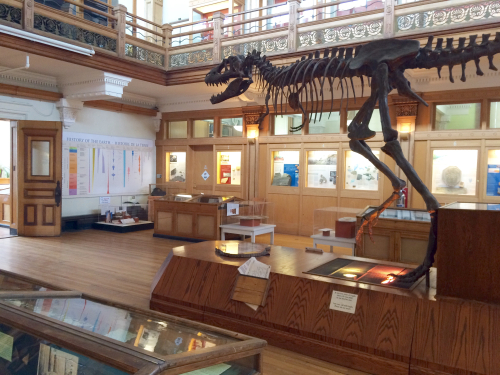
Four Pillars of the Redpath Museum: Palaeontology

PALAEONTOLOGY
When you read or hear the word “Palaeontology” the first thing that probably comes to mind is “Dinosaurs.” While some palaeontologists do study dinosaurs, the field is much broader and encompasses the study of all ancient life.
HISTORY
A large portion of the Redpath Museum’s historic collection is Palaeontological material, second only to the geology/mineralogy collection. These two areas are the most well-represented in the historic collection of the Museum because they were the two specialties of the Museum’s first director: Sir John William Dawson.
Sir William Dawson was best known to his contemporaries as a palaeobotanist—a scientist who studied ancient plants. During his exploration of fossilized trees in Joggins, Nova Scotia, he made his most famous discovery: the oldest known reptile fossil ever to be discovered, which he named Hylonomus lyelli. Several of the specimens shown in this case were collected by Dawson himself!
ON DISPLAY
The top shelf holds the teeth of three different animals from the Pleistocene to early Holocene periods (about 1.8-0.0117 million years ago). From left to right, these teeth are from a horse, ancient elephant, and fox, respectively. Notice how the horse and elephant teeth have wavy groves in them, while the fox teeth are pointed. This is because the horse and elephant were herbivores, while the fox was a carnivore.
The middle shelf holds specimens from the Triassic, Jurassic and Cretaceous periods (251.9—66 million years ago) which is often associated with dinosaurs. In the centre, you can see part of a femur of an unidentified dinosaur species. To the right are two Ichthyosaur teeth. Interestingly, Ichthyosaurs are not considered dinosaurs. This is because ichthyosaurs are marine reptiles, and the word ‘dinosaur’ can only be applied to land reptiles. Finally, to the left of the dinosaur bone is a stone with coprolite in its centre. Coprolite is the scientific name for fossilized feces.
The bottom shelf holds the oldest specimens, from the Cambrian to Permian periods (541—251.9 million years ago) On the left is a fossil of a plant collected by Dawson himself! In the centre, there is a fossil of an early species of fish. Sometimes it is hard to tell what species you are looking at in a fossil because often the features get blurred and crumpled after sitting in the rock strata for hundreds of millions of years. On the right is a fossil of a trilobite: one of the earliest known types of arthropods.
The Redpath Museum contains over 12,000 catalogued specimens including some of the first known vascular plants and the earliest lobe-finned fishes! Want to learn more about the Palaeontology collection? Look to the right as you leave the auditorium to look at more marine reptiles, and then head up to the Dawson gallery, where you can meet our dinosaur friends and look at many other types of plant and animal fossils!